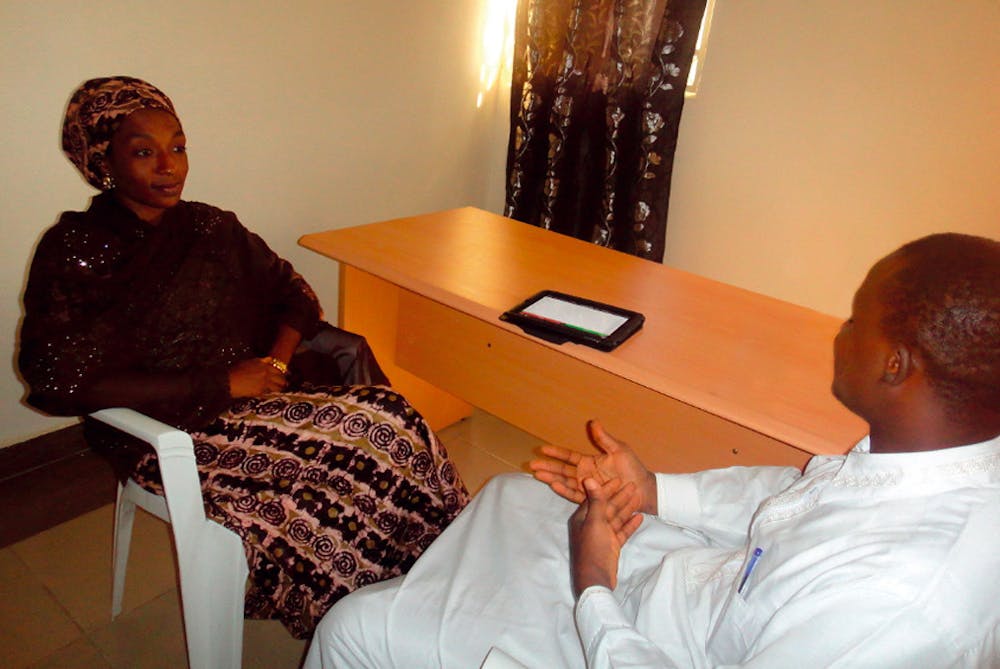In the Institute for Computational Medicine (ICM) special seminar series on Oct 3., Assistant Professor at the Integrated Mathematical Oncology Department at H. Lee Moffitt Cancer Center & Research Institute Renee Brady shared insights on using minimally invasive biomarkers to predict treatment responses. The talk shed light on using dynamics of patient-reported outcomes (PROs) as alternative treatment strategies, ultimately contributing to the reduction of cancer health disparities. Her team’s research findings were recently published in Clinical Cancer Research.
According to Brady, the study of mathematical oncology traces back to the early 2000s. In the early days, most models were conceptual and highlighted the universal dynamics of cancer mechanisms and proliferation. As the field evolved and more knowledge was gained on the dynamics of different diseases, models that were cancer-specific and patient-specific were developed.
PROs are data directly reported by patients at various points throughout their care. In contrast to typical toxicity measures conducted by clinicians, PROs are more accessible and capture the patients’ internal experiences. While PROs have not yet been integrated into the diagnostic framework, their importance has emerged in the field of cancer precision and personalized medicine.
PROs have proven to be promising diagnostic markers by previous work. In a recent paper titled “Randomized Trial Comparing a Web-Mediated Follow-up with Routine Surveillance in Lung Cancer Patients,” researchers compared web-mediated treatments, which are based on self-reported symptoms, to standard surveillance. If self-reported PROs indicated a progression in disease, an alert email would automatically be sent to the patients and would recommend they check in with their oncologist. Brady elaborated on this example during the event.
“This is an example of how PROs work. When looking at the Kaplan-Meier plots for this trial, it is found that the median time to survival in the web-based group was about 22.5 months and the control group was about 13.5 months,” she elaborated. “So you can see that the median overall survival [of the patients in the web-mediated treatment group] was extended.”
Brady’s research primarily focuses on non-small cell lung cancer (NSCLC), which accounts for 80–85% of all lung cancers. Given that NSCLC progresses asymptomatically, patients are often diagnosed at the advanced stage of the disease.
To address the research question — can PROs be used dynamically as inter-radiographic predictors of treatment response in NSCLC? — Brady conducted a study involving 85 NSCLC patients undergoing immunotherapy. The research had the patients complete biweekly PRO questionnaires and receive monthly tumor volume scans.
When analyzing the raw data for correlation between PRO dynamics and CT volumes, Brady and her team found that changes in volume were significantly correlated with dizziness (p<0.005), insomnia (p<0.05) and fatigue (p<0.05). Further analysis revealed that changes in insomnia could predict progressive disease with 77% accuracy, with correct predictions of progressive disease occurring on average 45 days prior to the next imaging study.
“This was an example of where we could have actually saved the patient because, in theory, if we’re just looking at their CT scans, and they’re waiting every six months, they probably would have missed that point when they could have switched therapy at the right time to prolong their survival,” Brady explained.
Brady is currently employing dynamic modeling of PROs to inspect prostate-specific antigen dynamics in patients undergoing intermittent therapy. Distinct models were trained for each patient, with models calibrated with existing data before projecting forward to predict future responses.
Brady discussed the limitations of the research due to the subjective nature of PRO measures. Take insomnia as an example: Though existing research has confirmed its association with functional status and cancer cell proliferation, it is still understudied and may be confounded. She emphasized resolving this confounding effect with further validation studies as a future direction.
“We want to show that this can actually translate to other cancers or even the same cancer from the larger data set,” she said.
There is an ongoing validation study with about 350 NSCLC patients at the Moffitt Cancer Center.
In addition, Brady is working on improving the predictive power of mathematical modeling.
“There is a dire need to predict precisely when a patient will progress. Right now, the only information is whether that progression will occur. Clinicians often want to know when exactly that will happen so that they can decide whether they have enough time for therapy or if it is worth switching therapy. We are still trying to get there,” she said.
In closing, Brady highlighted the collaborative nature of this research.
“This is like a two-way street. We get information from the clinical side, and in the center, we take all human data and develop mathematical models,” she added. “Then we try to inform the clinicians as to how to administer treatments for cancer.”
Seminar faculty host and Associate Director of the ICM Dr. Casey Taylor shared that the goal of the ICM seminar series is to hear from globally recognized experts in an accessible way. In a statement to The News-Letter, Taylor recognized Brady's success in this arena.
“Brady’s talk was a particularly good example of this by her defining complex concepts in a way that was accessible to a broad audience,“ Taylor said. “A key takeaway from her presentation was that measures of the patient experience are largely underutilized to make cancer care more personalized. Considering those data along with more traditionally collected clinical measures can better characterize and predict patient disease progression.”





